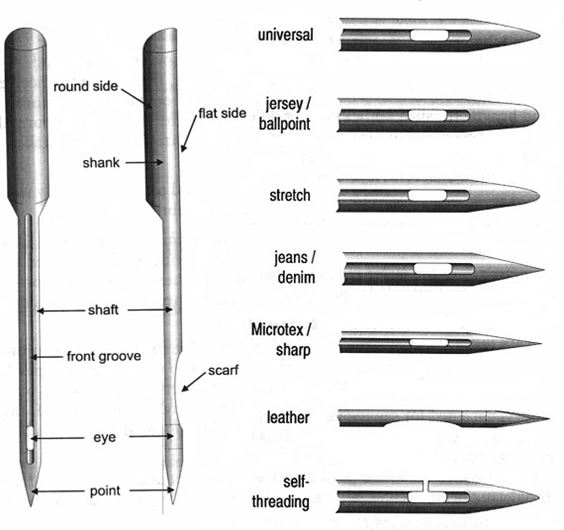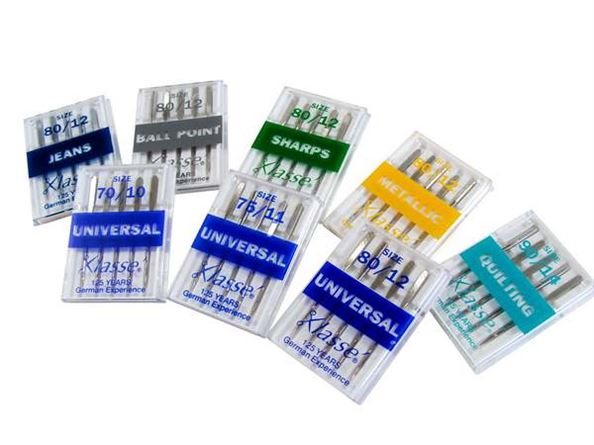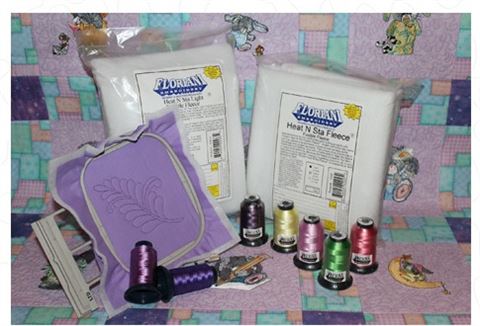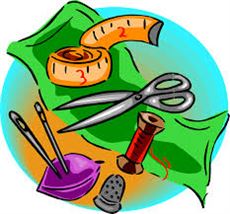Sewing Needles…….Do you just replace your sewing needles by grabbing the first package you see? Maybe you just buy the lowest priced ones? Or do you actually know what size and type to get? Sewing needles may not appear all that important but an incorrect needle can wreak havoc on your project. If you’ve been encountering such things as skipped stitches, puckering, needle breakage, poorly formed stitches, loose stitches, etc., then maybe you’re not using the best needle for your project.
You probably noticed sewing needles are available in a large variety of types and sizes. And there is a reason for the different sizes and types. The success of your sewing project depends on using the right needle, whether you are hand sewing or machine sewing. Let’s take a look at needles and learn how to choose the correct needle(s) for your next project! Think positive results for your ReSEWlutions!
Machine Needles
Machine needles are more complex than hand needles because they are designed for specific threads and fabrics. Look at the picture to see the “anatomy” of a machine needle.  The most important area on this diagram is the lower end of the needle. Notice the “eye”, “point”, “scarf” and “groove”. These are what you should be most aware of when purchasing machine needles.
The most important area on this diagram is the lower end of the needle. Notice the “eye”, “point”, “scarf” and “groove”. These are what you should be most aware of when purchasing machine needles.
- The groove is a hollowed out path along the shaft for the thread to lay in as it passes to the eye. This helps the thread flow smoothly from machine to fabric.
- The eye holds the thread in place for the bobbin hook to pick it up and create the stitch.
- The scarf is the indentation on the backside of the needle around the eye. It is usually on the opposite side of the groove. The scarf allows the bobbin hook to get really close in to the thread. This helps create the proper tension to form the perfect stitch.
- The point is the part of the needle that pierces the fabric first. The shape and size of the point determine whether it simply parts the fabric or cuts the fabric to pierce it.
It is the changes in these areas that determine the type of needle and when to use it.
The size is determined by the diameter of the “shaft” which is also referred to as the “body”.
Types of Machine Needles
Universal – this is the most commonly used machine sewing needle type. But it may not be the best one for your project. The universal needle is made to pass through the fabric without cutting it or causing a run. It has a slightly rounded point and is intended for use on woven fabrics but also works on some knits.
- Available in a large variety of sizes
- Less expensive than specialty needles
- Great for everyday sewing
Ballpoint/Jersey – this needle is made for use on t-shirt type knit fabric. Its ballpoint design allows it to pass through fabric without damaging the fibers of the fabric. If stitches skip, then try a stretch needle.
- Also available in a large variety of sizes
- Perfect for sewing cotton knits or cotton/poly knits
Stretch – this needle design is made for synthetic stretch fabrics like swimwear or synthetic stretch suede. It also has a ballpoint, but the eye and the scarf are noticeably different from a regular ballpoint needle.
- Great for sewing elastic
- Available in a variety of sizes, more limited than regular ballpoint.
- Perfect for all synthetic knits with high “lycra” or “elastane” content
- Will not damage fabric when used correctly
Embroidery – this needle is a must when machine embroidering. It has a larger eye to accommodate specialty embroidery threads. Also, both the groove and scarf are modified for smoother thread flow. It has a medium point which is neither ballpoint nor sharp.
- The needle to use for most machine embroidery
- Most manufacturers offer at least 3 sizes. It typically comes in size 75/11, 80/12, and 90/14. Also comes in 100/16
- Not for use with dense embroidery designs or most metallic thread
Quilting – this needle is the best choice when machine quilting. It has a tapered shaft and extra sharp point that allows it to pass through several layers of fabric and batting with ease.
- Available in 75/11 and 90/14. You may see 80/12 instead of 75/11 depending on brand
- Perfect for free motion quilting
- smoothly takes thread cleanly through multiple layers of woven fabric
Denim – this needle is made to stitch through multiple layers of denim or heavy weight fabrics smoothly. It has a deeper scarf, modified shaft, and modified point. The shaft has also been reinforced to limit bending and breaking.
- Available in larger sizes 90/14, 100/16, and 110/18. You may also find size 125/20 and size 80/12 but these are not often as available.
- Great for use on any heavy woven including heavy upholstery fabrics
- You can even try this on faux leather, “pleather”, and vinyl
- Remember to stitch at slower speeds for optimal results

Sewing Needles for more Specialized Sewing
Microtex – made to stitch synthetic wovens which have a tight weave or with a high thread count. It has an extremely narrow, sharp point to cleanly pierce through dense fabrics.
- The “go to” needle for all tightly woven fabrics such as microfiber
- Available in a variety of sizes
- Great for delicate fabrics like silk or chiffon
- Should be used for embroidery on microfiber and synthetic leather/suedes
Metallic – this needle is specially made for using metallic threads. It typically features a universal point with an enlarged, elongated eye and much larger groove. These differences allow metallic and synthetic filament thread to flow through the needle with less friction. You will notice more even tension with less thread breakage.
- Use with any metallic thread or synthetic filament thread
- Prevents skipped stitches and thread breakage
- Available in a variety of sizes
- Also available in Twin needle
- Best needle for most fabric types where metallic or synthetic filament threads are used
Topstitch – has an extra large eye and groove, plus super sharp point for smoother use of thick thread. It can also be used to seam extra heavy or thick fabric.
- Use with any thicker thread such as 12 wt. thread
- Available in larger sizes 90/14, 100/16, and 110/18
- Test on scrap to use smallest size needle so you avoid visible stitch “holes” in fabric
- Best for use on wovens
- Great for creating special effects with various specialty threads on machine embroidery
Leather – is the choice for stitching real leather. It has an extra sharp point. The point cuts the fabric rather than piercing it. This needle will damage most fabrics and synthetic leathers. The shaft has been reinforced to prevent it from breaking or bending.
- Should only be used on real leather or extremely thick non woven vinyl type fabrics
- For thicker thread, try a topstitching needle first
- Use smallest size needle you can to prevent visible needle “holes”
- If needle keeps breaking, then switch to larger size needle or try larger topstitching needle
- Remember – not for synthetics. You should use a microtex for synthetic leather and suede, vinyl, and “pleather”
Hemstitch – also called a wing needle. It is often referred to as the “Heirloom Sewing Needle”. The shaft has “fins” or blades added to it that slice through the fabric. This forms small holes in the fabric creating the heirloom hand stitching look found on fine fabrics.
- Always test on scrap fabric with smallest size first
- This needle is meant to form holes in the fabric and will cut fibers
- Best when used with special Heirloom stitches
- Use with any stitch that will go through the same hole more than once
- Stabilizer may be necessary on very delicate fabrics to keep the fabric from tearing
So the next time you embark on a sewing project, make sure you pay attention to the kind of needle you on using. The correct sewing needles will certainly make it easier for you to achieve your ReSewlutions for 2017! (See last week’s blog).
Tips for Machine Sewing Needles
Tips for successful results on your next creative sewing project:
- Look at the type and weight of the fabric you will be using, then choose appropriate needle for the fabric
- Examine all the threads you want to incorporate into your design, then adjust needle sizes and types to work on your fabric with the desired threads. Example: To embroider on Ultrasuede with 12 weight wool, you may want to test both a metallic needle and a topstitch needle before using a microtex needle.
- Don’t be afraid to experiment!
Another important note about machine sewing needles – Make sure you change them. You should be using a new or “fresh” needle at the beginning of every project. Since most of us don’t count the number of stitches we use in a project, a good rule of thumb is to change out your needle every 6 to 8 hours of sewing time on any project. Remember to change your needle throughout your project as you apply different threads, fabrics and techniques.
Rocky Mountain Sewing carries all types and sizes of needles for any project you wish to create. Our friendly staff will cheerfully assist you with any questions about machine needles. Drop in and check out our selection of needles and threads. If you don’t see the needle you are looking for, please ASK! If you would like to take a seminar class where you would actually get to try out the different machine needle types and sizes, PLEASE LET US KNOW.
We have locations in Aurora, Colorado Springs, Littleton, and Arvada.
Make sure you sign up to get our newsletter, plus special offer and sale notices.
Special Offers: Get special deals on sewing machines
Hand sewing needles as well as Double, Triple, ad Spring Needles will be featured in next week’s blog.
Comments
Surain
This is amazing blog post.
cmorelli
We appreciate the comment!
Beulah Gragert
Thanks for the information. Good to know the difference.
cmorelli
Thank you! Make sure you check the next blog for Part 2 on needles!
Karlene Fuller
I really enjoyed your article and feel it was very informative for all of us who sew. This provides very critical information to aide in making your sewing experience successful. Thank you and definitely keep up the great contribution to sewing and quilting enjoyment!